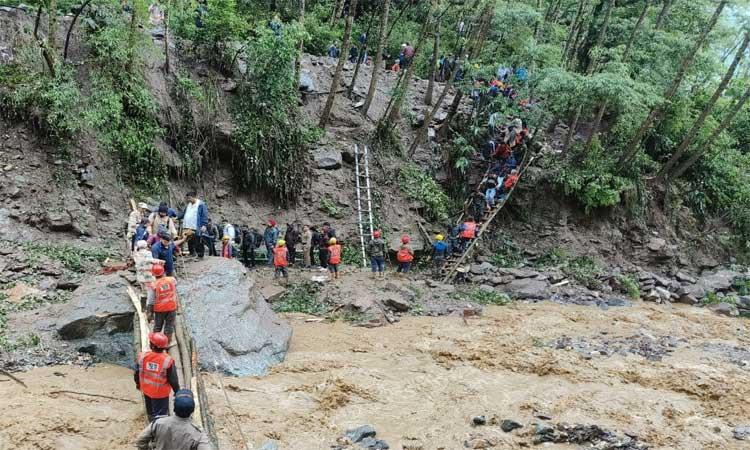The number of bodies recovered from the northern sector of West Bengal following the devastating flash-flood in adjacent hill-state of Sikkim has increased to 22 as of Friday, as per the records of the state disaster management department.
At least, 17 were recovered till Friday morning. The bodies were mainly recovered from the overflowing Teesta River in Jalpaiguri district in the northern sector.
As per the initial estimates of the state disaster management department, of the 22 bodies recovered at least six are of the Indian army personnel posted at Sikkim who went missing following the flash flood.
"More bodies might be recovered as the work of recovery and rescue operations progress," an official from the disaster management department said.
The bodies recovered so far have been preserved at four different hospitals at Malbazar, Maynaguri, Jalpaiguri Town in Jalpaiguri district and in North Bengal Medical College & Hospital at Siliguri In adjacent Darjeeling district.
Meanwhile, the National Highway 10 connecting north Bengal with Sikkim has been damaged following landslides. Sate disaster management department sources said that smaller relief and rescue vehicles are being sent to different parts of Sikkim through an alternative route, which is of a longer distance than the conventional route.
“Several tourists from West Bengal are still stranded at different parts of Sikkim. The figure is estimated to be around 3,000. Fortunately, the weather conditions have started improving from Friday morning and the pace of relief and rescue operations can be accelerated. We expect to bring back a substantial number of stranded tourists from the state there by Saturday afternoon,” the state disaster management department official said.
Climate change plays crucial role to intensify Sikkim floods: Experts
This week, what was reportedly a cloudburst over the glacial south Lhonak Lake caused it to breach its embankment.
While water initially breached the Chungthang dam, it resulted in flash floods in multiple areas of the hilly state of Sikkim.
According to meteorologists, while the weather conditions were conducive for heavy to very heavy precipitation over the region on account of a low-pressure area in the nearby region, this time’s flash flood wasn’t just a result of another extreme weather event alone.
Climate change has played a significant role in making this weather event more extreme.
The event was predicted in 2021, when a study brought forth information about the increasing length of Lhonak glacial Lake, which was sensitive to extreme weather events such as cloudbursts. Since it cannot be predicted when glacier-related floods, including floods from lake outbursts would burst, the only option is being prepared with proper disaster planning and mitigation.
“It was already predicted in 2021 that this lake would breach and impact the dam. There has been a substantial increase in the number of glacial lakes as the glaciers are melting due to global warming. When the glaciers advance, they erode the river bed, leading to the deepening of the river,” explained Indian Institute of Technology-Indore glaciologist Farooq Azam.
“Also, climate change has resulted in erratic precipitation, including events like cloudbursts, as we saw in Sikkim, leading to the partial breach of the moraine dam. When glaciers are eroding, they put pressure on the bedrock, producing more silt. Whenever there is flash flooding, you would witness more silt and debris flowing downhill, aggravating the destruction caused by floods and landslides.”
While these glacial lakes are mostly located in remote and unsettled mountain valleys, glacial lake outburst floods have the potential to impact several kilometers downstream, causing damage to human lives as well as assets and infrastructure.
Glaciologists and scientists have been warning against the rapid rise in the glacial lakes. Owing to the recent developments in terms of infrastructure and human settlements within the mountainous regions of the Himalayas, the existence of glacial lakes in the high altitude of the Himalayas has become a major concern to the downstream communities.
The South Lhonak glacier is one of the fastest retreating glaciers, and the associated proglacial lake has become the largest and fastest-growing in the state.
The glacier receded two km in 46 years from 1962 to 2008. It further retreated by 400 m from 2008 to 2019. There has been a growing concern now about the hazard potential of this lake, as the downstream valley is heavily populated with numerous settlements and infrastructure.
Glacial lake outburst floods can also be triggered by extreme meteorological conditions, especially heavy rainfall events that cause degradation of the damming moraine and lead to overfilling of the lake.
Studies have shown that glacial lake outburst floods risk will likely increase in the future, considering the increase in the number of new lakes, and increased triggering potential.
Also, the changing patterns of exposure are an equally important driver of glacial lake outburst floods risk. The width of the terminal moraine that dams the south Lhonak Lake is not uniform and is thinning towards the ends. Hummocky surface of the dam indicates that it likely contains buried ice and is subject to future degradation.
“Eastern Himalayas are dominated by monsoon, which has over the period become more erratic and unpredictable. Snowfall is food for glaciers but it is now replaced by rainfall that too erratic. There are more days of heavy rains and dry periods are also increasing. Rise in global warming has led to rise in glacial melt,” added Azam.
Glacier is a moving mass of ice, soil and rocks and thus, it consists of lots of loose sediments.
According to geologists, the retreating glaciers have left behind unlimited sediments which consist of an unstable mix of earth and rocks in the higher reaches of Himalayas.
In such cases, even less rainfall is good enough to move the boulders and debris downstream.
Seismic activity can in principle also lead to the degradation of the moraines' structural integrity, although not necessarily leading to an outburst and is an obvious trigger of large catastrophic ice or rock avalanches.
“Both the frequency and severity of such events are going to increase exponentially in the future. Himalayan ecosystem is the most fragile in the world and any disruption in the way we are managing these resources will have a problematic outcome for the people of the region,” said Anjal Prakash, Clinical Associate Professor- Research and Research Director, Bharti Institute of Public Policy, Indian School of Business and IPCC Author.
“Rising temperatures are leading to a wetter future and contributing to climate change led extreme events but it is also disturbing the fragility of the Himalayan ecosystem through hydropower and other dams. The glacial lake outburst flood is an outcome of warming of the region and this has been a major risk for the region. Once it is formed, you never know what triggers its outburst. Sikkim is an example of this only,” Prakash added.
Read also| After Sikkim, flood situation worsens in north Bengal parts
Read also| Centre forms team to assess damage by glacial lake outburst flood in Sikkim


















